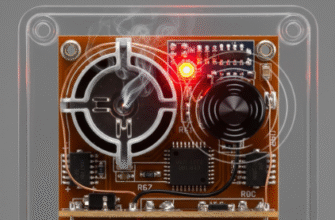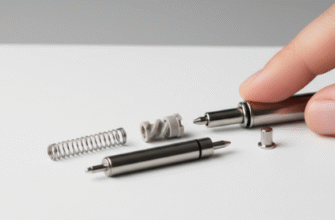Ever wondered about that unassuming box on your wall? The one you adjust when you’re feeling a bit too chilly or overly warm? That’s the thermostat, the silent conductor of your home’s climate orchestra. While modern digital versions boast fancy screens and smart features, the fundamental principle behind even the most basic, old-school thermostat is a fascinating blend of simple physics and clever engineering. It acts as a temperature-sensitive switch, telling your heating or cooling system when to kick in and when to take a break, all to maintain the comfort level you desire.
The Heart of the Matter: Sensing Temperature
At its core, a basic thermostat needs a way to reliably detect the ambient air temperature. Unlike digital thermostats that use electronic sensors called thermistors, traditional mechanical thermostats typically rely on one of two ingenious methods: the bimetallic strip or a gas-filled bellows. Both leverage the predictable physical property of materials expanding when heated and contracting when cooled.
The Bimetallic Strip: A Tale of Two Metals
This is perhaps the most common mechanism in older, non-digital thermostats. Imagine sandwiching two thin strips of different metals together – often brass and steel are used. Why different metals? Because different metals expand and contract at different rates when the temperature changes. Brass, for instance, expands more significantly than steel for the same temperature increase.
Now, bond these two strips tightly together, usually by riveting or brazing. What happens when the room warms up? Both metals try to expand, but the brass wants to expand more than the steel. Since they are bonded together and can’t separate, this difference in expansion forces the combined strip to bend. The brass will be on the outer side of the curve because it needs more room to expand. Conversely, when the room cools down, the brass contracts more than the steel, causing the strip to bend in the opposite direction, with the steel now on the outside of the curve.
This bending motion is the key. The bimetallic strip is often coiled into a spiral to make it more compact and increase its sensitivity to small temperature changes. The free end of this coil moves predictably back and forth as the room temperature fluctuates around the desired setting.
Gas-Filled Bellows: Pressure Play
Another, though slightly less common, mechanical approach involves a small, sealed metal canister or bellows containing a specific gas. Gases, like solids and liquids, also expand when heated and contract when cooled. When the room temperature rises, the gas inside the bellows heats up and expands, increasing the pressure inside the canister. This increased pressure causes the flexible bellows to physically expand, like inflating a tiny accordion. When the temperature drops, the gas contracts, pressure decreases, and the bellows shrink. Similar to the bimetallic strip, this expansion and contraction provides the physical movement needed to operate the switch.
Making the Connection: The Switching Mechanism
Okay, so we have a component (bimetallic coil or bellows) that moves in response to temperature. How does this movement actually control a powerful furnace or air conditioner? The answer lies in a simple electrical switch.
The moving part of the temperature sensor (the end of the bimetallic coil or the expanding bellows) is positioned very close to an electrical contact point. Often, there’s a small vial containing mercury attached to the moving element (in older thermostats – these are less common now due to environmental concerns) or a simple mechanical snap-action switch.
Let’s focus on a heating scenario with a bimetallic coil. As the room cools, the coil winds tighter (or bends in a specific direction). Eventually, as the temperature drops below your set point, the moving end of the coil tilts or pushes enough to make electrical contact. This might involve tilting a mercury switch so the liquid metal bridges two contacts, or physically pressing down on a small lever to close a circuit in a snap switch. This completed circuit signals the furnace: “Time to turn on!”
Once the furnace starts running and the room temperature begins to rise, the bimetallic strip warms up. It starts to uncoil or bend back. When the temperature rises slightly above the set point, the strip moves far enough in the opposite direction to break the electrical contact. The circuit opens, and the signal to the furnace stops: “Okay, you can turn off now.” The process for controlling an air conditioner is similar, but the switch contacts are arranged to close the circuit when the temperature rises above the set point, telling the AC to turn on, and open when it cools back down.
Setting Your Comfort Zone: The Dial or Lever
How do you tell the thermostat what temperature you actually want? That’s where the dial or lever comes in. Adjusting the temperature setting on a basic thermostat doesn’t change how the bimetallic strip or bellows reacts to temperature – that’s fixed by the laws of physics. Instead, it changes the position of the electrical switch contacts relative to the temperature-sensing element.
Think of it like this: turning the dial to a higher temperature physically moves the switch contact further away from the ‘cold’ position of the bimetallic strip. This means the room has to get significantly warmer before the strip bends enough to reach the contact point and turn off the heat (or turn on the AC). Conversely, setting a lower temperature moves the contact closer, requiring less movement (and thus a lower temperature) to trigger the switch.
Essentially, you’re adjusting the threshold – the exact point in the sensing element’s travel where the electrical circuit is completed or broken.
Understanding Temperature Swing (Differential)
If a thermostat turned the heating on the instant the temperature dropped even a fraction below the set point, and off the instant it rose above, your heating system would be constantly cycling on and off every few seconds. This would be incredibly inefficient, noisy, and hard on the equipment. To prevent this rapid cycling, basic thermostats incorporate a concept called temperature differential, or “swing”.
This means the thermostat waits for the temperature to drop a degree or two below the set point before turning the heat on, and then waits for it to rise a degree or two above the set point before turning it off. This small buffer zone creates a more manageable cycle. The mechanism for this can be built into the snap-action switch design or sometimes involves small magnets near the contacts (an anticipator, though that adds a layer of complexity beyond the most basic). The result is that the room temperature will naturally fluctuate slightly around your set point, typically within a 2-4 degree Fahrenheit range.
Did You Know? The principle behind the bimetallic strip is fundamental to its operation. Because the two bonded metals expand at different rates (e.g., brass expands more than steel), changes in temperature force the strip to bend. This reliable physical reaction provides the mechanical movement needed to trigger the thermostat’s switch, requiring no external power for the sensing function itself.
Simplicity vs. Modern Complexity
While effective, these basic mechanical thermostats lack the precision and features of their modern digital counterparts. Digital thermostats use electronic sensors (thermistors) that offer faster response times and greater accuracy. They allow for precise temperature settings (often to half a degree), programmability for different times of day, Wi-Fi connectivity for remote control, and learning capabilities to optimize energy use. However, the fundamental goal remains the same: sense the temperature and switch the heating/cooling system accordingly. The basic mechanical thermostat achieves this with remarkable simplicity, relying on elegant physical principles rather than complex electronics.
So, the next time you adjust that simple dial, appreciate the clever mechanics at work inside. That basic thermostat is a testament to how fundamental physics – the expansion and contraction of materials – can be harnessed to provide essential home comfort, reliably keeping your space just the way you like it without needing any complex circuitry or software. It’s a small machine doing a big job, ensuring your environment stays comfortable, season after season.







